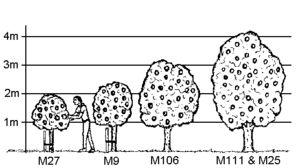Malling series
"Malling series" is an apple rootstock.
History

Rootstocks used to control tree size have been used in apple for over 2,000 years. Dwarfing rootstocks were probably discovered by chance in Asia. Alexander the Great sent samples of dwarf apple trees back to his teacher, Aristotle in Greece. They were maintained at the Lyceum, a center of learning in Greece.
Dwarf apples are mentioned during the Song Dynasty in China (11th to 13th centuries) Initial propagation was likely by severing a root and causing it to sucker. The dwarfing clones were propagated in gardens for their novelty and not their efficiency. They were often trained to elaborate shapes such as pyramids, trellises and espaliers. In the mid-1800s, horticulturists began referring to the rootstocks by name. They were called Paradise (or French Paradise) or Doucin (or English Paradise), with the former being more dwarfing than the latter.
However, there was much variation in the plant material in size control. Many new stocks had been introduced inaccurately under these names and undoubtedly viruses and genetic mutations had occurred in the plant material. In the late 19th century, one author described 14 different kinds of Paradise rootstocks. This led to research workers at the East Malling Research Station in England to gather the selections up to determine their trueness to name. They concluded that indeed, there were numerous misnamed and mixed collections of plant material.
In 1912, Ronald Hatton initiated the work of classification, testing and standardization of apple tree rootstocks. With the help of Dr Wellington, Hatton sorted out the incorrect naming and mixtures then widespread in apple rootstocks distributed throughout Europe. These verified and distinct apple rootstocks were then distributed throughout the world as Types, initially Type I through Type IX.
Several of the Malling series rootstocks are several hundred years old and were known by other names before the Malling research center created a rootstock collection and renamed the rootstocks as follow :
- M.I (M.1), vigorous, had no name,
- M.II (M.2), vigorous, was "English Paradise" or "Doucin de Fontenay",
- M.III (M.3), semi-dwarf, had no name,
- M.IV (M.4), intermediate, was "Doucin jaune de Holstein",
- M.V (M.5), vigorous, was "Doucin amélioré" (Improved doucin),
- M.VI (M.6), very vigorous, was "River's nonsuch paradise",
- M.VII (M.7), semi-dwarf, was "Doucin Reinette" aka "Doucin vert", bred around 1688 in France,
- M.VIII (M.8), dwarf, was "french paradise" (Malus pumila) aka "Clarke dwarf",
- M.IX (M.9) was previously known as "Jaune de Metz" or "Paradis". Selected as chance seedling in France in 1828.
- M.XVI (M.16), Very vigorous, was "Ketziner Ideal"
Only two of these original Malling selections, M.9 (Jaune de Metz) and M.7, are now used extensively by commercial orchardists. Later, further types were added to the original nine, though most of these were invigorating rootstocks which have since disappeared largely from commerce.
In 1917 a second research station, the John Innes Centre of Merton near London, England, joined with the East Malling station to begin a breeding program. Their efforts, oriented mainly toward developing rootstocks resistant to woolly apple aphids, produced two series of clones. The first was the Merton Immune series (MI number) M.I. 778-793 (1930’s), which is the only one still being used commercially. It is commonly referred to as Merton 793. The second series were designated the Malling-Merton (M.M.) series in 1952. These were numbered M.M. 101 — 115. Resistance to WAA was acquired by making crosses with 'Northern Spy'. Even later three additional Malling stocks were introduced: M.25 in 1952, M.26 in 1965 and M.27 in 1976.
During the 50's - 70's, two virus indexed (heat-treated) series were released. First was the EM series and then later the EMLA (East Malling-Long Ashton) series. The series with viruses removed are slightly more vigorous than their "dirty" predecessors of which MM.106 and MM.111 are still used widely today.
Malling-Merton series
- 'M25': Very vigorous.
- 'M26': Moderately dwarfing, M.16 x M.9, introduced in 1959.
- 'M27': Very dwarfing.
- 'MM106': Moderately vigorous, M.1 x Northern Spy': Drought-resistant.
- 'MM111': Vigorous. Merton 793 x Northern Spy
References
Notes
Bibliography
External links
- New rootstocks for apple
- Orchards for beginners
- Rootstocks
- List and description of rootstocks
- Apple rootstock identification — NSW Department of Primary Industries — Series: Agfact H4.1.10 – Edition: Second edition – Last updated: 12 Jun 2001
- Apple Rootstock Fact Sheets, listed by size class
| |||||||||||||||||

